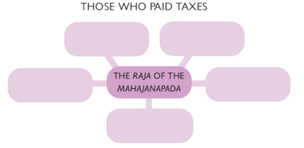NCERT Solutions for Class 6 Social Science History Chapter 5 Kingdoms, Kings and An Early Republic contains answers to all the questions given in the exercise of the history book. These solutions have been created on the basis of NCERT Book Guidelines. The solutions are prepared in simple language by our subject experts to help students in their exam preparation.
Class 6 History Chapter 5 Kingdoms, Kings and An Early Republic Questions and Answers
1. State whether true or false:
(a) ‘Rajas’ who let the ‘ashvamedha’ horse pass through their lands were irwited to the sacrifice.
(b)The charioteer sprinkled sacred water on the king.
(c) Archaeologists have found palaces in the settlements of the ‘janapadas’.
(d) Pots to store grain were made out of Painted Grey Ware.
(e) Many cities in ‘mahajanapadas’ were fortified.
Answer:
(a) True
(b) False
(c) False
(d) True
(e) False
Question 2: Fill in the chart given below with the terms: hunter-gatherers, farmers, traders, craftspersons, herders.

Answer: Hunter-gatherers, farmers, traders, crafts-persons and herders—all paid taxes.
(i)Farmers—one-sixth of the produce.
(ii)Crafts-persons—in the form of labour.
(iii)Herders—in the form of animals and animal products.
(iv)Traders—taxes on goods brought and sold.
(v)Hunter-gatherers—forest produce.
Question 3: Who were the groups who could not participate in the assemblies of the ganas?
Answer: The following groups couldn’t participate in the assemblies of the ganas:
- Women
- Dasas, the slaves
- Kammakaras, the landless labourers
Question 4: Why did the rajas of mahajanapadas build forts?
Answer: The ‘rajas’ of ‘mahajanapadas’ built forts around their capital cities because probably the people were afraid of attacks from other kings and needed protection. It is also possible that some ‘rajas’ wanted to show that they were rich and powerful by building large, tall and impressive walls around cities. Moreover, by fortifying, the land and its people could be controlled more easily.
Question 5: In what ways are present-day elections different from the ways in which rulers were chosen in janapadas?
Answer: In janapadas, men became ‘rajas’ by performing the Ashvamedha sacrifice. The rajas who let the Ashvamedha horse pass through their lands meant that they accepted the supremacy of the raja who wanted to perform the sacrifice.
In modern times, leaders are elected through a democratic system. Every citizen who is 18 years or older has the right to cast his.her vote. The candidates who win the majority of votes become public leaders